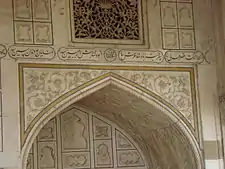Persian language in the Indian subcontinent
The Persian language in the Indian subcontinent, before the British colonized the Indian subcontinent, was the region's lingua franca and a widely used official language in north India. The language was brought into the Indian subcontinent by various Turkic and Afghan dynasties, in particular the Turko-Afghan Delhi Sultanate and the Mughal Dynasty. Persian held official status in the court and the administration within these empires and it heavily influenced many of the local languages, particularly modern standard Hindi and modern standard Urdu.
Evidence of Persian's historical influence there can be seen in the extent of its influence on the languages of the Indian subcontinent. Many of these areas have seen a certain influence by Persian not only in literature but also in everyday speech. Persian exerted a strong influence on Balochi (an Iranic language), Pashto (another Iranic language), and Urdu, but also a relatively strong influence on Indic languages such as Punjabi, Sindhi,Kashmiri,Gujarati. Other languages like Hindi, Odia, Marathi and Rajasthani also have a considerable amount of loan words from Persian.
Persian's official status was replaced with English in 1835 by British East India Company. After 1843, Hindustani and English gradually replaced Persian in importance in the Indian subcontinent as the British had full suzerainty over the Indian subcontinent.[1]
History
Following the Ghaznavid conquest of South Asia, Persian was firstly introduced in the subcontinent by Turco-Persians from Central Asia.[2] The basis in general for the introduction of Persian language into the subcontinent was set, from its earliest days, by various Persianized Central Asian Turkic and Afghan dynasties.[3] For five centuries prior to the British colonization, Persian was widely used as a second language in the Indian subcontinent, due to the admiration the Mughals (who were of Turco-Mongol origin) had for the foreign language. It took prominence as the language of culture and education in several Muslim courts on the subcontinent and became the sole "official language" under the Mughal emperors.
Following the defeat of the Hindu Shahi dynasty, classical Persian was established as a courtly language in the region during the late 10th century under Ghaznavid rule over the northwestern frontier of the subcontinent.[4] Employed by Punjabis in literature, Persian achieved prominence in the region during the following centuries.[4] Persian continued to act as a courtly language for various empires in Punjab through the early 19th century serving finally as the official state language of the Sikh Empire, preceding British conquest and the decline of Persian in South Asia.[5][6][7]
Beginning in 1843, though, English and Hindustani gradually replaced Persian in importance on the subcontinent.[8] Evidence of Persian's historical influence there can be seen in the extent of its influence on certain languages of the Indian subcontinent. Words borrowed from Persian are still quite commonly used in certain Indo-Aryan languages, especially Urdu (also historically known as Hindustani), Punjabi and Sindhi.[9] There is also a small population of Zoroastrian Iranis in India, who migrated in the 19th century to escape religious persecution in Qajar Iran and speak a Dari dialect.
Bengal
The Bengal Sultanate witnessed an influx of Persian scholars, lawyers, teachers and clerics. Thousands of Persian books and manuscripts were published in Bengal. The period of the reign of Sultan Ghiyathuddin Azam Shah, is described as the "golden age of Persian literature in Bengal". Its stature was illustrated by the Sultan's own correspondence and collaboration with the Persian poet Hafez; a poem which can be found in the Divan of Hafez today.[10] A Bengali register emerged amongst the common Bengali Muslim folk, based on a Persian model. Known in the modern-day as Dobhashi among other names, this register of Bengali was patronised and given official status under the Sultans of Bengal; whose first language was Persian, and was the most popular literary form used by Bengalis during the pre-colonial period, irrespective of their religion.[11]
Persian inscriptions
The basis for the introduction of Persian language into the Indian subcontinent was set, from its earliest days, by various Persianized Central Asian Turkic and Afghan dynasties.[12] Thus, when the early Turks, Afghans, and Turko-Persians imported the language to the Indian subcontinent, they laid the basis for its patronisation in the centuries to come, notably by the Delhi Sultanate (who were once again of Turko-Afghan origin) and the Mughals (who were of Turko-Mongol origin). There are many stone carvings and plasters of Persian inscriptions in India. There are also many handwritten books mostly from the time of Humayun, a Mughal emperor who had heavy admiration for anything West Asian, and Persian in particular. Humayun lost Mughal territories to the Pashtun noble, Sher Shah Suri, but, with the aid of the powerful West Asian Safavids, regained them 15 years later. Humayun's return from Persia, accompanied by a large retinue of Persian noblemen, signaled an important change in Mughal court culture, as the Central Asian origins of the dynasty were largely overshadowed by the influences of Persian art, architecture, language, and literature. There are many carved stones and Persian manuscripts in the Indian subcontinent from the time of Humayun.
Subsequently, in a very short time, Humayun was able to expand the Empire further, leaving a substantial legacy for his son, Akbar. His peaceful personality, patience, and non-provocative methods of speech earned him the title Insan-i Kamil (انسان کامل), meaning literally perfect man, among the Mughals.[13]
See also
- Lisan ud-Dawat, Perso-Arab-influenced Gujarati
- Persian Inscriptions on Indian Monuments (book)
Gallery


 Calligraphy of Persian poems (18th century)
Calligraphy of Persian poems (18th century) Persian poem
Persian poem Persian inscription
Persian inscription Persian poem
Persian poem
References
- Clawson, Patrick (2004). Eternal Iran. Palgrave Macmillan. p. 6. ISBN 1-4039-6276-6.
- Bennett, Clinton; Ramsey, Charles M. (2012). South Asian Sufis: Devotion, Deviation, and Destiny. A&C Black. p. 18. ISBN 978-1-4411-5127-8.
- de Laet, Sigfried J. (1994). History of Humanity: From the seventh to the sixteenth century. UNESCO. ISBN 978-92-3-102813-7., p 734
- Mir, F. (2010). The Social Space of Language: Vernacular Culture in British Colonial Punjab. University of California Press. p. 35. ISBN 9780520262690. Archived from the original on 9 February 2018. Retrieved 13 January 2017.
- Chisholm, Hugh, ed. (1911). . Encyclopædia Britannica. 22 (11th ed.). Cambridge University Press. p. 892.
- Grewal, J. S. (1990). The Sikhs of the Punjab, Chapter 6: The Sikh empire (1799–1849). The New Cambridge History of India. Cambridge University Press. p. 112. ISBN 0-521-63764-3.
The continuance of Persian as the language of administration.
- Fenech, Louis E. (2013). The Sikh Zafar-namah of Guru Gobind Singh: A Discursive Blade in the Heart of the Mughal Empire. Oxford University Press (USA). p. 239. ISBN 978-0199931453.
We see such acquaintance clearly within the Sikh court of Maharaja Ranjit Singh, for example, the principal language of which was Persian.
- Clawson, Patrick (2004). Eternal Iran. Palgrave Macmillan. p. 6. ISBN 1-4039-6276-6.
- Menon, A.S.; Kusuman, K.K. (1990). A Panorama of Indian Culture: Professor A. Sreedhara Menon Felicitation Volume. Mittal Publications. p. 87. ISBN 9788170992141. Archived from the original on 9 February 2018. Retrieved 13 January 2017.
- Abu Musa Mohammad Arif Billah (2012). "Persian". In Islam, Sirajul; Miah, Sajahan; Khanam, Mahfuza; Ahmed, Sabbir (eds.). Banglapedia: the National Encyclopedia of Bangladesh (Online ed.). Dhaka, Bangladesh: Banglapedia Trust, Asiatic Society of Bangladesh. ISBN 984-32-0576-6. OCLC 52727562. Retrieved 29 January 2021.
- Sarah Anjum Bari (12 Apr 2019). "A Tale of Two Languages: How the Persian language seeped into Bengali". The Daily Star (Bangladesh).
- Sigfried J. de Laet. History of Humanity: From the seventh to the sixteenth century UNESCO, 1994. ISBN 9231028138 p 734
- Farooqi, Naimur Rahman (1989). Mughal-Ottoman relations: a study of political & diplomatic relations ... - Naimur Rahman Farooqi - Google Boeken. Retrieved 2012-08-14.
Further reading
- Chopra, R. M., The Rise, Growth And Decline of Indo-Persian Literature, Iran Culture House, New Delhi, 2012.
Sources
- "History of Persian or Parsi Language" — Iran Chamber Society
- — soas.ac.uk
- Catalogue of Persian manuscripts in the library of the India office, Volume 1 (1903)